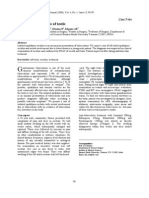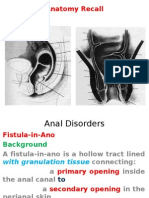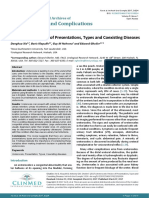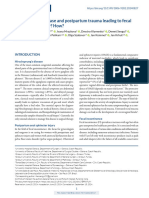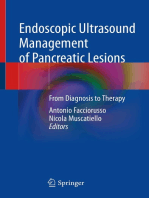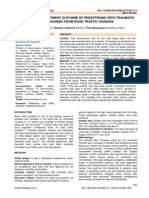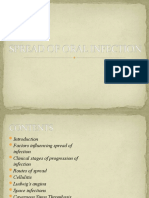44 Apoorv Etal
44 Apoorv Etal
Uploaded by
editorijmrhsCopyright:
Available Formats
44 Apoorv Etal
44 Apoorv Etal
Uploaded by
editorijmrhsOriginal Description:
Copyright
Available Formats
Share this document
Did you find this document useful?
Is this content inappropriate?
Copyright:
Available Formats
44 Apoorv Etal
44 Apoorv Etal
Uploaded by
editorijmrhsCopyright:
Available Formats
DOI: 10.5958/j.2319-5886.3.1.
044
International Journal of Medical Research & Health Sciences
www.ijmrhs.com Volume 3 Issue (1 Jan- Mar) Coden: IJMRHS th Received: 11 Nov 2013 Revised: 8th Dec 2013 Case report Copyright @2013 ISSN: 2319-5886 Accepted: 13th Dec 2013
SPONTANEOUS NEPHROCUTANEOUS FISTULA IN TUBERCULOUS PYELONEPHRITIS: AN UNUSUAL OCCURRENCE Apoorv Sharma1, *Zeeshanuddin Ahmad1, Arpan choudhary1, Moolchand Songra2
1 2
MS Senior Resident, Department Of Surgery, GMC Bhopal, Madhya Pradesh, India HOD and Professor, Department Of Surgery, GMC Bhopal, Madhya Pradesh, India
*Corresponding author email: zee_kmc03@rediffmail.com ABSTRACT Nephrocutaneous fistula has an uncommon incidence and occur usually as a complication of operative procedures on kidneys, renal injuries (penetrating or iatrogenic), renal uroliths, renal tumors and chronic UTI with resultant perirenal abscesses. The most common causes identified are renal calculi and chronic renal tuberculosis. We intend to highlight a case of a woman aged 35years, complaining of watery discharge through the skin in the right lumbar region for the past six months. A fistulogram was done which showed the passage of contrast dye in the collecting system. The patient underwent a simple nephrectomy on the concerned side and recuperated without any complication in the postoperative period. Keywords: Kidney, Fistula, Renal tuberculosis, Nephrocutaneous. INTRODUCTION Spontaneous nephrocutaneous fistula (NCF) is a rare condition. Majority develop secondary to postoperative, trauma, chronic urinary tract infection, renal stones1. Few cases as a complication of xanthogranulomatous pylonephritis has also been reported to the literature2, however occurrence of this condition due to renal tuberculosis is a rare phenomenon. The fistula may be internal (the fistulous communication between kidney and adjacent viscera like colon, duodenum, or jejunum) or external, like nephrocutaneous fistula.3We report a rare case of Spontaneous nephrocutaneous fistula due to renal tuberculosis. CASE REPORT Complaints - A 35 year old female presented with complaint of insidious onset watery discharge from her right flank for 6 months. There was no history of loin pain, back pain, lump in abdomen, fever, frequency of Apoorv et al., urination or burning micturition at any time during the course of illness. She never underwent any surgical intervention in the past. There was also no history of previous purulent discharge. Examination -The physical examination revealed a fistulous orifice in the skin on the right lumbar region with surrounding induration. Examination of chest, abdomen, spine and genitourinary systems was unremarkable. There was no lymphadenopathy. On examination watery discharge was of ammoniacal smell. Culture and sensitivity of the discharge and urine were sterile. X-ray chest, spine and KUB were normal. Routine blood tests including renal functions were normal and patient was not found diabetic. Investigation - A fistulogram was done which showed the passage of contrast dye in the right collecting system travelling down freely up to the ureter and bladder (Figure 1). Excretory urography revealed nonfunctioning right kidney with normal function 205 Int J Med Res Health Sci. 2014;3(1):205-207
opposite side. Ultrasound abdomen revealed small right kidney with significant cortical loss and fistula site biopsy was inconclusive. Treatment- In view of non functioning right kidney, nephrectomy was planned with excision of the fistula. Intraoperatively shrunken, atrophic kidney was found adhered to the surrounding tissue and perinephric fat with caseous material filled in (Putty kidney). After careful separation from surrounding tissue simple nephrectomy was performed by excision of the entire fistulous tract including skin and subcutaneous tissue. Histopathology - Histopathological examination of the specimen showed tuberculous pyelonephritis. The postoperative period was uneventful. Patient was started on antitubercular drugs and was discharged on the seventh post-operative day.
reports favor open surgical procedure being commonest. 8 Tuberculous pyelonephritis usually starts in renal parenchyma and ureters and bladder are secondarily involved. The mode of spread is hematogenous. Three pathological stages have been described. At any stage, when there is significant fibrosis and outlet obstruction, the pus may find its way along the path of least resistance-forming renocutaneous, reno-colic or reno-pleural fistula. The case under discussion had total outlet obstruction in proximal ureter due to progressive fibrosis and obstruction causing atrophic, putty kidney and renocutaneous fistula. The clinical features related to renal tuberculosis are variable and range from simple fatigue, anorexia and weight loss, to the attacks of loin pain and haematuria. Other features depend upon the stage of disease and extent of involvement. Apart from routine investigations, culture and sensitivity of urine, abdominal ultrasound, fistulography, excretory urography and DTPA renal scintigraphy are important diagnostic tools. Early changes are best detected by excretory urography / pyelography while chronic changes are evaluated with the help of ultrasound or CT scan. Plain films are helpful in detecting lesions in the lungs and areas of calcification in kidneys, adrenals and adjacent lymph nodes. The standard treatment of nephrocutaneous fistula is nephroureterectomy with complete debridement of affected perirenal fat, muscles, and subcutaneous tissue. The surgery is followed by anti-TB regimen and long-term follow-up. Classification of TB Pyelonephritis I: Nondestructive (infiltrate) tuberculosis of kidney II: Initial destruction (papillitis or small, by diameter about 1 cm, single cavity); III: Marked destruction (caverns or policavernosial tuberculosis one of kidney segments); IV: Total or subtotal destruction (policavernose tuberculosis, tubercular pyonephrosis, calcification). They distinguish three forms of tuberculosis: tuberculoinfiltrative, ulcerous and scar. CONCLUSION We highlight here the rarity of spontaneous nephrocutaneous fistula and renal tuberculosis as an important differential diagnosis to be kept in mind in the Indian scenario. 206
Fig 1: Fistulogram showing passage of contrast agent to the right collecting system freely up to the bladder
DISCUSSION Spontaneous nephrocutaneous fistula without previous surgical history is rare.4 Most of the cases reported in the literature was associated with chronic UTI, renal tumors, renal tuberculosis and nephrolithiasis. Patients often overlook minor complaints of backache and flank pain; such neglected cases often harbor an underlying perinephric abscess5 that may lead to the genesis of a spontaneous NCF. A review of literature suggests renal calculus being the most common cause followed by tubercular and xanthogranulomatous pyelonephritis and reflux disease. 6,7 However some Apoorv et al.,
Int J Med Res Health Sci. 2014;3(1):205-207
REFERENCES 1. Singer AJ. Spontaneous nephrocutaneous fistula. Urology 2002; 60(6): 110910. 2. Biyani CS, Torella F, comford PA, Brough SJ. Xanthogranulomatous pyelonephrins with bilateral Nephrocutaneous fistulae. Urol Int 1997: 59: 4647. 3. Ansari MS, Singh I, Dogra PN. Spontaneous nephrocutaneous fistula2 unusual case reports with review of literature. Int Urol Nephrol. 2004;36:23943. 4. Alberto A, Antunes, Adriano A, Calado, Evandro F. Spontaneous nephrocutaneous fistula. International Braz J Urol 2004; 30: 316-18. 5. Karfopoulos AS, Murray W, Stone FJ. Nephrocutaneous fistula. J Med Soc NY 1981; 78: 379. 6. Iseki T, Kawamura M. Spontaneous passage of renal calculi through nephrocutaneous fistula due to calculous pyelonephritis. Br J Urol 1987; 59(3): 28586. 7. Lewi HJE, Scott R. Calculocutaneous sinus. Urology. 1986;28:23234. 8. Das S, Ching V. Nephrocutaneous sinus: a case report. J Urol 1979; 122: 232. 9. Hargreave TB. The kidney and ureter. In: Cusheiri A, Giles GR, Moosa AR, (edi). Essential surgical practice, 3rd ed. Oxford. Butterworth- Heinemann; 1995:1487.
207 Apoorv et al., Int J Med Res Health Sci. 2014;3(1):205-207
You might also like
- TB of The TestesDocument2 pagesTB of The Testesntambik21No ratings yet
- Department of Molecular Virology: COVID-19 (Corona) VirusDocument1 pageDepartment of Molecular Virology: COVID-19 (Corona) VirusShahzad Ali100% (1)
- Obstructive NephropathyDocument4 pagesObstructive NephropathyKevean Kimi LimNo ratings yet
- PylonefritisDocument8 pagesPylonefritissintaNo ratings yet
- Tulþies Pûslës Apsisukimas: Gallbladder VolvulusDocument3 pagesTulþies Pûslës Apsisukimas: Gallbladder VolvulusVytautas LiutvinasNo ratings yet
- Perforación Vesical Espontánea - Una Complicación Rara de La TuberculosisDocument3 pagesPerforación Vesical Espontánea - Una Complicación Rara de La Tuberculosisjudith paz villegasNo ratings yet
- Urethral Stricture: Etiology, Investigation and TreatmentsDocument8 pagesUrethral Stricture: Etiology, Investigation and TreatmentsAchmad RandiNo ratings yet
- Pionefroze EnglDocument10 pagesPionefroze EnglArief MunandharNo ratings yet
- 906-Article Text-3039-1-10-20231221Document3 pages906-Article Text-3039-1-10-20231221Sofie NNo ratings yet
- 02 02 Original PyonephrosisDocument4 pages02 02 Original PyonephrosisArief MunandharNo ratings yet
- Accessory Spleen: V. Durgesh, CH. Roja RaniDocument3 pagesAccessory Spleen: V. Durgesh, CH. Roja RaniIOSRjournalNo ratings yet
- Intestinal Obstruction Due To An Obturator Hernia: A Case Report With A Review of The LiteratureDocument2 pagesIntestinal Obstruction Due To An Obturator Hernia: A Case Report With A Review of The Literaturemudasir61No ratings yet
- Rui 2007Document5 pagesRui 2007Radiologi RSPDNo ratings yet
- Ajol File Journals - 384 - Articles - 103954 - Submission - Proof - 103954 4573 280090 1 10 20140603Document5 pagesAjol File Journals - 384 - Articles - 103954 - Submission - Proof - 103954 4573 280090 1 10 20140603lana qwqwMagdyNo ratings yet
- Bazo Errante 2016 REVISED Ijtra1601084Document4 pagesBazo Errante 2016 REVISED Ijtra1601084luisalfredo_montesNo ratings yet
- Case Report Severe Dysplasia of Kidney 20082021Document15 pagesCase Report Severe Dysplasia of Kidney 20082021Nikko Caesario Mauldy SusiloNo ratings yet
- 857 PDFDocument8 pages857 PDFLana LocoNo ratings yet
- Cystogram With Dumbbell Shaped Urinary Bladder in A Sliding Inguinal HerniaDocument12 pagesCystogram With Dumbbell Shaped Urinary Bladder in A Sliding Inguinal Hernia6281326189433No ratings yet
- 4 2 - 181 182 PDFDocument2 pages4 2 - 181 182 PDFNam LeNo ratings yet
- Ijrms-12417 CDocument5 pagesIjrms-12417 CSamuel MedinaNo ratings yet
- S R R P: Pontaneous Upture of Enal ElvisDocument3 pagesS R R P: Pontaneous Upture of Enal ElvisArsy Mira PertiwiNo ratings yet
- Page 4062693Document53 pagesPage 4062693alexandermarcusNo ratings yet
- Cystogram With Dumbbell Shaped Urinary Bladder in A Sliding Inguinal HerniaDocument3 pagesCystogram With Dumbbell Shaped Urinary Bladder in A Sliding Inguinal HerniaSuhesh Kumar NNo ratings yet
- Mycobacterium Tuberculosis Osteomyelitis in ADocument15 pagesMycobacterium Tuberculosis Osteomyelitis in AMhd NasrudinNo ratings yet
- Extra Pelvic Endometriosis: Double Ileal and Ileo-Caecal Localization Revealed by Acute Small Bowel Obstruction, A Clinical CaseDocument9 pagesExtra Pelvic Endometriosis: Double Ileal and Ileo-Caecal Localization Revealed by Acute Small Bowel Obstruction, A Clinical CaseIJAR JOURNALNo ratings yet
- 19-22 Aortoenteric Fistula A Possible Cause of Sudden DeathDocument4 pages19-22 Aortoenteric Fistula A Possible Cause of Sudden DeathLoredana MorosanuNo ratings yet
- Crim Urology2013-932529Document3 pagesCrim Urology2013-932529TheQueensafa90No ratings yet
- Diagnosis of A Strangulated Laparoscopic Incisional Hernia With Point-of-Care UltrasonographyDocument3 pagesDiagnosis of A Strangulated Laparoscopic Incisional Hernia With Point-of-Care UltrasonographysaminNo ratings yet
- Case Report Aditya - Jurnal VancoverDocument6 pagesCase Report Aditya - Jurnal VancoverAditya AirlanggaNo ratings yet
- Anal Fistula2Document43 pagesAnal Fistula2api-19641337No ratings yet
- International Archives of Urology and Complications Iauc 3 024Document9 pagesInternational Archives of Urology and Complications Iauc 3 024Anonymous 2ernTkNo ratings yet
- Complex Case of Ureteropelvic Junction Obstruction 2024 International JournaDocument3 pagesComplex Case of Ureteropelvic Junction Obstruction 2024 International JournaRonald QuezadaNo ratings yet
- Colovesical Fistula PDFDocument4 pagesColovesical Fistula PDFWilliam WiryawanNo ratings yet
- Journal 2Document3 pagesJournal 2Wahyu Pranata PardedeNo ratings yet
- Hirschprung's Disease and Postpartum Trauma Leading To Fecal Incontinence: Why? How?Document5 pagesHirschprung's Disease and Postpartum Trauma Leading To Fecal Incontinence: Why? How?flaviasturraNo ratings yet
- Subsidence of Hypertension in A Patient With GiantDocument4 pagesSubsidence of Hypertension in A Patient With GiantSinbijeo GinNo ratings yet
- Tuberculous Ileal Perforation in Post-Appendicectomy PeriOperative Period: A Diagnostic ChallengeDocument3 pagesTuberculous Ileal Perforation in Post-Appendicectomy PeriOperative Period: A Diagnostic ChallengeIOSRjournalNo ratings yet
- Appendicular Abscess NewDocument4 pagesAppendicular Abscess NewkucingdekilNo ratings yet
- Urologic EmergenciesDocument11 pagesUrologic EmergenciesdewiNo ratings yet
- Assessment and Management of Clinical Problems. St. Louis (Missouri: Elsevier, MosbyDocument1 pageAssessment and Management of Clinical Problems. St. Louis (Missouri: Elsevier, MosbysukebebeNo ratings yet
- Hunner Lesion (Formerly Known As Hunner'S Ulcer)Document4 pagesHunner Lesion (Formerly Known As Hunner'S Ulcer)Vasishta NadellaNo ratings yet
- Non-Traumatic Rupture of Spleen Can Splenectomy BeDocument3 pagesNon-Traumatic Rupture of Spleen Can Splenectomy Beysh_girlNo ratings yet
- Complications of Percutaneous Nephrostomy Tube Placement To Treat NephrolithiasisDocument4 pagesComplications of Percutaneous Nephrostomy Tube Placement To Treat NephrolithiasisPande Made FitawijamariNo ratings yet
- Urethral Injury in Penile FractureDocument6 pagesUrethral Injury in Penile FractureBeno This isNo ratings yet
- Case Report Intus Draft 20-03-23Document3 pagesCase Report Intus Draft 20-03-23Sravan JsNo ratings yet
- Rupture of Urinary Bladder: A Case Report and Review of LiteratureDocument3 pagesRupture of Urinary Bladder: A Case Report and Review of LiteratureAmanda Samurti PertiwiNo ratings yet
- HydronephrosisDocument3 pagesHydronephrosisCarla AlmerolNo ratings yet
- Krukenberg Tumour Simulating Uterine Fibroids and Pelvic Inflammatory DiseaseDocument3 pagesKrukenberg Tumour Simulating Uterine Fibroids and Pelvic Inflammatory DiseaseradianrendratukanNo ratings yet
- Percutaneous Nephrolithotomy in Case of Crossed Fused Renal Ectopia: A Case ReportDocument3 pagesPercutaneous Nephrolithotomy in Case of Crossed Fused Renal Ectopia: A Case ReportDr.ankit AnandNo ratings yet
- 104 Laparoscopic Treatment of Traumatic Bladder RuptureDocument3 pages104 Laparoscopic Treatment of Traumatic Bladder RuptureAswad AffandiNo ratings yet
- Huraib 1989Document5 pagesHuraib 1989dong duongNo ratings yet
- DX TX ApendikDocument5 pagesDX TX ApendikAhmed MawardiNo ratings yet
- Biopsi Gin Malang 2021 DR NovadianDocument31 pagesBiopsi Gin Malang 2021 DR NovadianwandaNo ratings yet
- Pemeriksaan IVPDocument41 pagesPemeriksaan IVPChandra Noor SatriyoNo ratings yet
- Block of Kidney and Urinary Tract SystemDocument52 pagesBlock of Kidney and Urinary Tract Systemgaruda nusantaraNo ratings yet
- Fistula-In-Ano Extending To The ThighDocument5 pagesFistula-In-Ano Extending To The Thightarmohamed.muradNo ratings yet
- Bab I PendahuluanDocument23 pagesBab I PendahuluanChrisna Anastasia Futunanembun RayaNo ratings yet
- Endoscopic Ultrasound Management of Pancreatic Lesions: From Diagnosis to TherapyFrom EverandEndoscopic Ultrasound Management of Pancreatic Lesions: From Diagnosis to TherapyAntonio FacciorussoNo ratings yet
- Diseases of the Liver and Biliary TreeFrom EverandDiseases of the Liver and Biliary TreeAnnarosa FloreaniNo ratings yet
- Ijmrhs Vol 4 Issue 3Document263 pagesIjmrhs Vol 4 Issue 3editorijmrhsNo ratings yet
- Ijmrhs Vol 3 Issue 4Document294 pagesIjmrhs Vol 3 Issue 4editorijmrhsNo ratings yet
- Ijmrhs Vol 4 Issue 2Document219 pagesIjmrhs Vol 4 Issue 2editorijmrhsNo ratings yet
- Ijmrhs Vol 4 Issue 4Document193 pagesIjmrhs Vol 4 Issue 4editorijmrhs0% (1)
- Ijmrhs Vol 3 Issue 3Document271 pagesIjmrhs Vol 3 Issue 3editorijmrhsNo ratings yet
- Ijmrhs Vol 2 Issue 2Document197 pagesIjmrhs Vol 2 Issue 2editorijmrhsNo ratings yet
- Ijmrhs Vol 3 Issue 1Document228 pagesIjmrhs Vol 3 Issue 1editorijmrhsNo ratings yet
- Ijmrhs Vol 2 Issue 1Document110 pagesIjmrhs Vol 2 Issue 1editorijmrhs100% (1)
- Ijmrhs Vol 2 Issue 3Document399 pagesIjmrhs Vol 2 Issue 3editorijmrhs100% (1)
- Ijmrhs Vol 1 Issue 1Document257 pagesIjmrhs Vol 1 Issue 1editorijmrhsNo ratings yet
- Ijmrhs Vol 3 Issue 2Document281 pagesIjmrhs Vol 3 Issue 2editorijmrhsNo ratings yet
- 47serban Turliuc EtalDocument4 pages47serban Turliuc EtaleditorijmrhsNo ratings yet
- Ijmrhs Vol 2 Issue 4Document321 pagesIjmrhs Vol 2 Issue 4editorijmrhsNo ratings yet
- Recurrent Cornual Ectopic Pregnancy - A Case Report: Article InfoDocument2 pagesRecurrent Cornual Ectopic Pregnancy - A Case Report: Article InfoeditorijmrhsNo ratings yet
- 41anurag EtalDocument2 pages41anurag EtaleditorijmrhsNo ratings yet
- 48 MakrandDocument2 pages48 MakrandeditorijmrhsNo ratings yet
- 45mohit EtalDocument4 pages45mohit EtaleditorijmrhsNo ratings yet
- 36rashmipal EtalDocument6 pages36rashmipal EtaleditorijmrhsNo ratings yet
- 37poflee EtalDocument3 pages37poflee EtaleditorijmrhsNo ratings yet
- Williams-Campbell Syndrome-A Rare Entity of Congenital Bronchiectasis: A Case Report in AdultDocument3 pagesWilliams-Campbell Syndrome-A Rare Entity of Congenital Bronchiectasis: A Case Report in AdulteditorijmrhsNo ratings yet
- 40vedant EtalDocument4 pages40vedant EtaleditorijmrhsNo ratings yet
- Pernicious Anemia in Young: A Case Report With Review of LiteratureDocument5 pagesPernicious Anemia in Young: A Case Report With Review of LiteratureeditorijmrhsNo ratings yet
- 38vaishnavi EtalDocument3 pages38vaishnavi EtaleditorijmrhsNo ratings yet
- 28nnadi EtalDocument4 pages28nnadi EtaleditorijmrhsNo ratings yet
- 33 Prabu RamDocument5 pages33 Prabu RameditorijmrhsNo ratings yet
- 34tupe EtalDocument5 pages34tupe EtaleditorijmrhsNo ratings yet
- 35krishnasamy EtalDocument1 page35krishnasamy EtaleditorijmrhsNo ratings yet
- 31tushar EtalDocument4 pages31tushar EtaleditorijmrhsNo ratings yet
- Latihan Soal Analytical Exposition Kelas XDocument5 pagesLatihan Soal Analytical Exposition Kelas XdickyekoNo ratings yet
- Public Health Assignment 4Document5 pagesPublic Health Assignment 4Katherine ChristinaNo ratings yet
- Med Surg Care StudyDocument32 pagesMed Surg Care StudyNaFizzNo ratings yet
- NCP Self Care DeficitDocument3 pagesNCP Self Care DeficitLeizel ApolonioNo ratings yet
- Attempt All Questions in Order. Each Question Carries 10 MarksDocument4 pagesAttempt All Questions in Order. Each Question Carries 10 MarksunitedpraiseNo ratings yet
- NEWV2 Calendar RNDocument5 pagesNEWV2 Calendar RNxbppkstgqdNo ratings yet
- Spread of Oral InfectionDocument67 pagesSpread of Oral InfectionAMIT GUPTANo ratings yet
- Mental Health Case Study 1Document12 pagesMental Health Case Study 1api-507291324No ratings yet
- Cakir2021 Lactatealbumin Ratio Is More Effective Than Lactate or Albumin Alone in Predicting Clinical Outcomes in Intensive Care Patients With SepsisDocument6 pagesCakir2021 Lactatealbumin Ratio Is More Effective Than Lactate or Albumin Alone in Predicting Clinical Outcomes in Intensive Care Patients With SepsisRazan RabiNo ratings yet
- Myasis, Tungiasis and LoiasisDocument34 pagesMyasis, Tungiasis and LoiasisMateo LópezNo ratings yet
- Cardio 21 Group Assignment Review - NPTE Final FrontierDocument19 pagesCardio 21 Group Assignment Review - NPTE Final FrontierNPTE بالعربيNo ratings yet
- Marik Covid Protocol Summary PDFDocument2 pagesMarik Covid Protocol Summary PDFJody VivasNo ratings yet
- Mr. Shlok MahajanDocument2 pagesMr. Shlok MahajanDr Narendra KaleNo ratings yet
- Xerophthalmia (Vitamin A Deficiency) : Ointment, One Application 2 Times Daily (Do Not Apply EyeDocument1 pageXerophthalmia (Vitamin A Deficiency) : Ointment, One Application 2 Times Daily (Do Not Apply EyeDita Ambarsari SyafruddinNo ratings yet
- Pathology of The ThyroidDocument39 pagesPathology of The ThyroidPriiya AshiwiniNo ratings yet
- Sample Test 4 PtA Text BookletDocument8 pagesSample Test 4 PtA Text BookletAparnnaNo ratings yet
- Transoral Laser MicrosurgeryDocument4 pagesTransoral Laser MicrosurgeryanniebuhrNo ratings yet
- MRI Safety Checklist English 032220Document1 pageMRI Safety Checklist English 032220phucNo ratings yet
- BIO101 ABO Blood GroupingDocument3 pagesBIO101 ABO Blood GroupingArik RaihanNo ratings yet
- Myopathy - SujathaDocument83 pagesMyopathy - SujathaRancho Vaibhav GuptaNo ratings yet
- Wikipedia - Metoclopramide (For CHECK)Document8 pagesWikipedia - Metoclopramide (For CHECK)pixoguiasNo ratings yet
- NSW Acute Coronary Stenosis (STEMI/NSTEMI) ProtocolDocument16 pagesNSW Acute Coronary Stenosis (STEMI/NSTEMI) ProtocolFaraz MahboobNo ratings yet
- Sleep PhysiologyDocument20 pagesSleep PhysiologyFareeha IffatNo ratings yet
- Case Scenario Mohsen SaadDocument6 pagesCase Scenario Mohsen SaadIbrahim HemdanNo ratings yet
- Chapter 21 RespiratoryDocument5 pagesChapter 21 RespiratoryJanet KayeNo ratings yet
- Pulse Rate BioDocument3 pagesPulse Rate Biosanique peterkinNo ratings yet
- Application of The International Classification of Diseases To Neurology (2nd Ed., 1997)Document586 pagesApplication of The International Classification of Diseases To Neurology (2nd Ed., 1997)I.m. DanielNo ratings yet
- The Homeopathic Treatment of Ear Infections PDFDocument104 pagesThe Homeopathic Treatment of Ear Infections PDFdipgang7174No ratings yet
- NURS FPX 6218 Assessment 1 Proposing Evidence-Based ChangeDocument6 pagesNURS FPX 6218 Assessment 1 Proposing Evidence-Based Changefarwaamjad771No ratings yet
